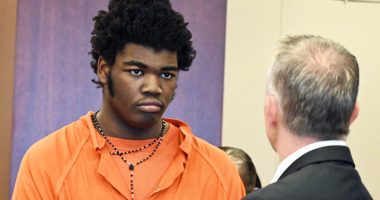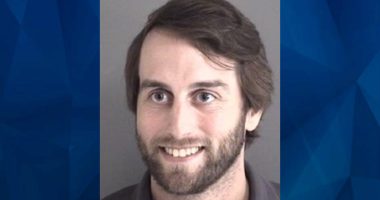When I moved into picturesque Nelson Street in Oxford seven years ago, I had no idea my house had been the scene of a real murder.
Perhaps I shouldn’t have been surprised. Jericho, my neighbourhood, was the setting for the very first crime investigated by TV’s Inspector Morse — and ever since that first episode was broadcast back in 1987, the line between reality and fiction in the city of dreaming spires has seemed to blur.
My house was once home to Florence Jeffreys, an unfortunate woman beaten to death by her son-in-law in 1993, shortly after he had killed his wife and daughter in another part of Oxford.
The Dead Of Jericho, the first story starring the late John Thaw as the irascible, opera-loving Morse, revolved around the apparent suicide of a woman (it turned out to be a murder, of course) living on ‘Canal Reach’, just a few yards from my front door.
It’s hard to walk through Oxford on a summer’s day without bumping into tourists eager to see the sites of the detective’s greatest breakthroughs. Morse is Oxford, and Oxford is Morse.


The Dead Of Jericho, the first story starring the late John Thaw (pictured) as the irascible, opera-loving Morse


Ever since that first episode was broadcast back in 1987, the line between reality and fiction in the city of dreaming spires has seemed to blur. Pictured: Shaun Evans as DC Endeavour Morse
The ancient colleges with their Cotswold stone exteriors and ornate gardens and quadrangles have proved the perfect backdrop to dozens of foul deeds committed by clever people with time on their hands to scheme, and worse.
The rarefied world of the Oxford dons Morse moves among is riven by jealousy, secrecy and intrigue. Somebody once said Oxford must be the murder capital of the world, as there was a brutal killing every week in Morse. A new college head of house jokingly told me his family had warned him against taking up a job in this danger zone.
To me, Morse is a special British creation, up there with James Bond. At its peak, the show was watched by 750 million viewers in 200 countries.
It made household names of John Thaw and Kevin Whately (who played Lewis, Morse’s sidekick); then Laurence Fox (who played the supporting role in the spin-off series, Lewis); then, more recently, Shaun Evans, Roger Allam and Anton Lesser in the ‘prequel’ series, Endeavour.
Now, after 36 years, the Morse franchise is coming to a close. A final, three-part series of Endeavour — to be broadcast in two-hour- long episodes on Sunday evenings — starts on ITV on February 26.
To mark the end of an era, we are holding a MorseFest in Oxford on March 4. I will be organising six now sold-out ‘Morse walks’ around the city, during which fans can drink a toast to the detective in one of his favourite bars — at the Randolph Hotel.
A celebration later, in a church in Jericho, is to be attended by John Thaw’s daughter, Abigail, who played the editor of the local paper in the series, and Anton Lesser, Chief Superintendent Bright in Endeavour.
Morse was the creation of Colin Dexter, a former school teacher- turned-(as he got older and deafer)-examinations official in Oxford. He began his first Morse novel, Last Bus To Woodstock, which took him 18 months to write, on a rainy holiday in North Wales in 1972.


The rarefied world of the Oxford dons Morse moves among is riven by jealousy, secrecy and intrigue. Somebody once said Oxford must be the murder capital of the world, as there was a brutal killing every week in Morse
Dexter loved cryptic crosswords: his fictional detective was named after his friend and champion cruciverbalist Jeremy Morse, chairman of Lloyds Bank. More than once, Morse’s own fondness for crosswords helped him track down criminals who had changed their names using anagrams.
Morse’s love of Mozart, Wagner and cask ale reflected Dexter’s own interests, but his crime-solving and uneasy relationship with his bosses was entirely a product of the author’s imagination.
Dexter famously never went close to a police station until well into the run of the later TV series. Morse’s intellectual interests inform his investigations. In the 1992 episode Cherubim And Seraphim, in which he investigates the suicide of his niece, Morse discusses the poetry of Sylvia Plath — who also killed herself — with the girl’s English teacher.
In Death Of The Self, also from the sixth series, he attends a performance of Wagner’s opera Twilight Of The Gods in Verona.
Dexter, like Morse, was a well-known figure in Oxford, but his reputation was mixed. He had a reluctance to put his hand in his pocket to pay for his round of drinks. This facet of his character is reflected in Morse, who rarely has change and often lands poor Lewis with the bill. A wood-panelled bar at The Randolph is named after Morse. Bills there are payable on demand.
TV came calling, appropriately, as Dexter was having a pint at the Dew Drop Inn in Oxford’s Summertown. Producers from Central ITV had scouted the Jericho locations and had a script for the first episode ready, written by the late Anthony Minghella.
Read Related Also: Cops Serve Search Warrant on House of Murdered Debbie Collier’s Daughter: Report
Dexter got royalties, fame and a cameo appearance in many of the episodes. He befriended the stars, who became his drinking pals.
As a piece of television, the secret was (and is) the two-hour episode length, which allowed stories to develop, helped by great writing and direction. Some British directorial greats cut their teeth on the franchise. TV drama seems to have moved on to police procedurals like Silent Witness and Happy Valley. So the Morse canon will now enter the listings of the archive channels.
But even there, I suspect, it will shine. Because part of Morse’s appeal is that it seems to reflect a bygone age of policing — at least for those of us old enough to remember it.
Unlike the modern-day Met, there are no rapists or murderers in this force — just gentlemen scholars as detectives. Dixon of Dock Green with a brain.
Morse was a B.A. Oxon (Failed) driving around in his distinctive red Jaguar (registration number 248 RPA) while listening to loud classical music.
In the script, the car was meant to be a Lancia — but John Thaw insisted on a Jag. That later sold for £100,000 — several times what a car of similar vintage would normally be worth.
Initially, Dexter’s detective — who loved chess as well as crosswords — was just ‘E. Morse’. He told anyone who asked that his first name was ‘Inspector’. His real first name — Endeavour — was not revealed until toward the end of the first run of 33 Morse films.


John Thaw and Colin Dexter, during the scene in which Colin makes his cameo appearance as a tourist in Oxford
Peter Neyroud CBE, QPM and B.A. Oxford (passed) was Chief Constable of the real Thames Valley Police — Morse’s force — as the TV series was being aired. He recalls, as a detective superintendent, hearing a colleague refer to him and his sideman behind his back: ‘Look what we’ve got — Morse and bloody Lewis.’ Coppers are not fond of intellectuals.
But a former Oxford detective inspector, Dermot Norridge, remembers how a cardboard cutout of John Thaw as Morse would take pride of place at annual Oxford CID dinners.
It then appeared in the window of St Aldates police station. Tour guides would point it out from the top deck of buses as ‘Morse’s station’. Meanwhile, any CID investigation involving an Oxford college became a ‘Morse job’. Morse put Thames Valley Police on the map.
Yet the only plaque to honour Morse in Oxford is outside ‘his’ station. Plans for a statue of Dexter outside the Dew Drop Inn never took off.
I have been pushing for years for Oxford City Council to create a simple ‘Morse Code’ — eight to ten distinctive plaques marking filming locations for the interested tourist to follow. Not rocket science — but, sadly, it seems to be beyond the imagination of local politicians.
So though generations of tourists have come to Oxford from all over the world to find Morse, it ain’t easy. You need to be a detective yourself. There are few signposts, just organised tours.
How much has Oxford benefited financially from hosting the Morse franchise? No one knows. Two years ago, I asked county and city council economists for an estimate of the ‘Morse Effect’ on Oxford. Answer came there none.
In some ways, I believe Oxford is almost ashamed of Morse. Mucky old television. Not quite ‘proper Oxford’. Maybe it is time to build a proper Morse tourist industry in the city. It could run and run.
I live surrounded by reminders of Morse. The Phoenix Picture House cinema in Jericho doubles as ‘Screen Two’ in an episode called The Silent World Of Nicholas Quinn. The overgrown cemetery St Sepulchre’s features in The Wench Is Dead. Most remembered in my neighbourhood is the day and night in 2007 when the Lewis team came to blow up 31 Nelson Street — ten houses along from mine — in Life Born Of Fire. The ensuing firecrackers and general hullaballoo were captured by local amateur cameraman Jim Wright. I turned his footage into a half-hour programme for my series My Jericho, featuring the recollections of Jim and the film’s director Richard Spence.
Then, of course, there is ‘Canal Reach’ — in reality Coombe Road, which leads to the Oxford Canal. Morse TV began life here in 1987. It is still there, with a boatyard still at the end.
It still confuses aficionados who come to ‘Canal Reach’ to find the Bookbinders pub from the very first episode. Exterior right; interior not. They walk in and do a double-take.
Even for us Oxford inhabitants it can be hard to keep up. Morse and Lewis often enter one college from the street and emerge in the quadrangle of another.
We will all say a sad goodbye to the cast of wonderful characters that sprang out of the mind of Colin Dexter and later writers. They are one of Oxford’s gifts to the world. Rest in Peace, Endeavour Morse. Your TV fans, including this one, will miss you.
n John Mair is the editor of Morse, Lewis, Endeavour And Oxford, published by Bite Sized books, and of Jericho Oxford (Chris Andrews Publications).







